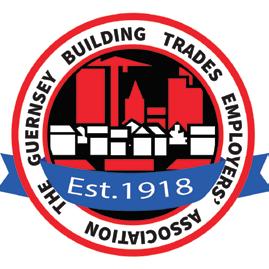
20 minute read
Apprenticeship awards
SET FOR SUCCESS
The recent GBTEA gala dinner and awards recognised the achievements of the island’s apprentices, and their importance to the industry.
Advertisement
138 people, including His Excellency, The LieutenantGovernor, Lieutenant General Richard Cripwell CB, CBE and his wife, joined GBTEA members and guests, representatives from the Guernsey College apprenticeship team and their tutors, and the nominated apprentices along their employers for the 2022 awards.
This year’s awards included two new categories, ‘Island Operative Pathway 1’ and ‘Welding and Fabrication’. Each winning apprentice received an engraved tankard, a certificate of their achievement and a £150 voucher from their sponsor, supplied by R H Gaudion & Son Ltd.
Along with the sector specific awards, the overall winner of the evening and the new holder of the R G Falla Rose Bowl was announced as Adam Quinn, who received not only the trophy but a cheque for £300 from R G Falla Ltd.
The winning apprentices weren’t the only ones to benefit on the night - £911 was also raised for this year’s chosen charity, ‘St John Ambulance Guernsey’.
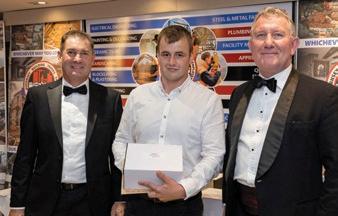
Craig Cox
Winner: Carpentry and joinery
Apprenticeship training with Wings Ltd Prize sponsored by C A Duquemin Ltd
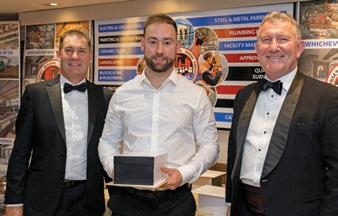
Sam Mahy
Winner: Electrical installations
Apprenticeship training with Island Electrics Ltd Prize sponsored by Amalgamated Facilities Management Ltd

Olliver Brehaut
Winner: “Ronez Young Achiever” in stone masonry skills
Apprenticeship training with Stoneworks Ltd Prize sponsored by Ronez Ltd
Adam Quinn
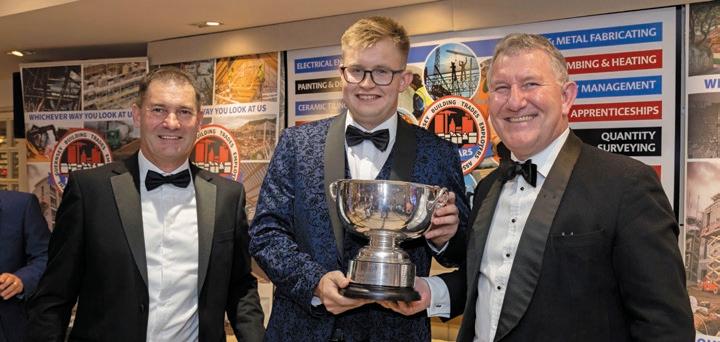
Winner: Plumbing and heating (and overall winner)
Apprenticeship training with Priaulx West Ltd Prize sponsored by Domestic Heating Services Ltd

Juris Drelings
Winner: Trowel trades
Apprenticeship training with Jon Matthews Prize sponsored by Hillstone Guernsey Ltd

Billy Prince
Winner: Painting and decorating
Apprenticeship training with Ounsworth Décor Ltd Prize sponsored by P3 Facades and Interior

Liam Torode
Winner: Island Operative ‘Pathway 1’
Apprenticeship training with Geomarine Ltd Prize sponsored by Geomarine Ltd

Daniel Naftel (award collected by his tutor, Aiden Harris-Smith)
Winner: Welding and fabrication
Apprenticeship training with Hamon Fabrications Ltd Prize sponsored by Channel Welders Ltd
Where has all the brownfield gone?
Chartered architect Oliver Brock of the Guernsey Society of Architects discusses the limitations of Guernsey’s opportunities for development.
In the debate over whether to build new or to convert existing buildings, it is often assumed that conversion is an economically viable option. Unfortunately, unless a developer is able to secure a significant increase in functional floor area, the figures rarely stack up, especially where a material change of use triggers a requirement to upgrade building fabric to accommodate the latest building regulation requirements. When considering restricted sites in and around the town centre it is uncommon to find existing buildings that readily lend themselves to useful and practical conversion.
‘Build on brownfield sites’, as the clamour has demanded recently, is not as straightforward as it seems, unless the brownfield site has been only barely developed, as might be the case with redundant glasshouse sites. Unfortunately, there are few of these in the centre of town; they tend to be found more on the outskirts, the development of which only barely supports the spatial strategy of the Strategic Land Use Plan, and would most likely only offer up low-rise low-density development.
What we need to look for is parcels of land in and around the centre of town that are relatively flat, relatively undeveloped and which don’t make an important contribution to our cherished seafront or historic townscape. Ideally these should be accessible and under very few or just one ownership.
We can scour the aerial photographs of the island to find perhaps three or four of these parcels. Typically those that we can identify are currently used for single level car parking. There is an obvious one at the Odeon car park in Upland Road, but the covenants on the use of this land would require some brains with a much greater legal bias than mine to unravel. Nearby, on the other side of the Grange, is a group of private car parking areas between the Platon nursing home and Vauvert School. In Hauteville there is a car park behind the Dorset Arms. These locations each offer approximately 2,000 square metres on footprint. It’s likely that as a society we’ll eventually fall out of love with the private motor car, but in the meantime these locations provide valuable congestion reducing vehicle parking for commuters and local residents.
Development could begin at first floor, covering the site area, and might yield any number of storeys of residential accommodation, perhaps enough for 30 or 40 two-three bedroom apartments each, and including amenity space, rooftop gardens and perhaps some leisure facilities. If we were in the more densely populated areas of the West Midlands in the UK, that kind of town centre development opportunity would be snatched up. Not just by a developer, but by end-purchasers off plan. The difference being that there would most likely already be some form of building shell to work with. The legacy of huge industrial buildings left over from the heyday of the canals and waterways in the cities and towns of that region has offered tall, clear span, open plan building structures ripe for conversion.
In Guernsey our built environment is made up of a tapestry of small footprint ownerships of low-rise buildings, with even smaller gaps between them. Developing open space in and around St Peter Port is a rare opportunity, and is complex and costly, and only by going big (high) can we expect to create a financial return that justifies the investment in such locations. What hope is there of squeezing more use out of our existing building stock on smaller plots when the sums just don’t offer any incentive? It isn’t so much that there is no brownfield land, it is that the cost of development of that land outweighs the end value when we limit ourselves to ‘more of the same’.

Local connections
Caroline Gumble, chief executive of the Chartered Institute of Building (CIOB), considers the importance of a recent visit by her organisation to the Channel Islands.
In October, the Chartered Institute of Building’s senior vice president Sandi Rhys Jones visited the Channel Islands, along with Marc Burton MBE FCIOB, our 2021 Construction Manager of the Year. They spent most of their time in Jersey, talking to CIOB members and the wider construction community.
It was very valuable visit, which started with a roundtable at which the organisers were delighted to have Suzanne Wylie, CEO of the Government of Jersey, as a panellist. Sandi took the opportunity to talk about the CIOB’s work on education and attracting young people to consider a career in construction, our Special Report on Diversity and Inclusion in Construction and the accompanying charter (more on which can be found on our website) and our recent report on lessons learnt during the pandemic.
This report, published in August, shows that since the Covid-19 pandemic struck, more than half of the SMEs surveyed have seen improvements to payment times, hygiene facilities and mental health support. It is encouraging to see some positives coming out of such a challenging time but there is still room for improvement within the industry. “Learning lessons from the Covid-19 pandemic to strengthen the construction industry” also offers recommendations for government, professional bodies and construction clients. It is also available for free to download from the CIOB website.
The roundtable event also provided more insights in the Design Engineer Construct (DEC!) programme, something in which Marc has been involved for years. I’ve written a little about this programme before as it has the potential to support the pipeline of talent into construction by putting construction and the built environment on the school curriculum. It was also a great venue for this particular event - thank you to Highlands College, Jersey for hosting.
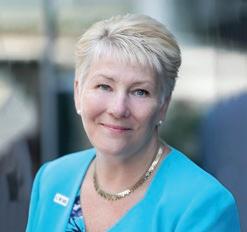
My thanks also to those who hosted site visits on for the CIOB visitors – they had the opportunity to go to two sites, with both projects being run by Chartered Building Companies, Camerons Ltd and ROK Construction. It’s worth flagging up our Chartered Building Company and Consultancy scheme – these are businesses that CIOB has assessed as being managed professionally and meeting ethical codes, allowing them to be recognised as a trusted resource by clients.
My thanks also to members of the National Association of Women in Construction’s new branch in Jersey – they met with Sandi and Marc on the Saturday and it already sounds like they have hit the ground running and are making fantastic progress.
It was great to hear there’s so much positive activity going on in Jersey and across the Channel Islands and great work by Sandi and Marc – and a whole host of others – in cheerleading for the sector and highlighting best practice where it’s taking place.
CIOB in the Channel Islands
As ever, if you would like to find out more about events being organised by our South UK Hub, do feel free join our LinkedIn group “CIOB in South UK” or check out the events section of the CIOB website.
A sustainable future
With his focus set clearly on legislation and education, John Bampkin, chair of the Guernsey Construction Forum (GCF), discusses the factors that will affect the island’s future sustainability.

As reported elsewhere in this magazine, I was recently invited to be a panelist at the Guernsey Chamber of Commerce’s “Sustainable Building” event, which was attended by approximately 100 people with a keen interest in learning more about building sustainably and responsibly in the island.
At the end of the event the panel was asked for our thoughts on the key thing that would push Guernsey along at the right pace to achieve our aims of “net zero by 2050 or sooner”. The overwhelming response answered unequivocally that both an improvement in building regulations and tighter legislation, coupled with an education campaign, is the only way to make this happen at the pace that is required.
We all know that we could and should be doing more, but left to our own devices as a collective we are not moving fast enough to protect our incredibly precious and precarious eco-systems and living spaces. Richard Spinney, who is an expert in sustainability and engineering, came out with a great quote, “everyone wants to change the world but nobody wants to change themselves”. I believe this is mostly true and is the main reason why the human race, even when it is faced with a threat to its own existence, can still sometimes move too slowly.
Therefore, legislation forcing people to do the right thing is the only way forward if we are to speed up this process.
This would mean improving the building regulations to match that of the UK – something known as “Part L”. This would ensure that any new-build properties would be much more thermally efficient than they are required to be by today’s outdated standards. All the materials required to do this are readily available from the UK, who have been building to Part L for 12 years. The other improvements necessary are around the education of both the construction industry at all levels and the general public or endclient. From the point of specification through to the person living or working in the property, a greater understanding on the options and solutions provided by today’s building materials and processes is needed. This will help us all make the right choices and ensure the quality of build is at the required levels for a resilient, effective and energy efficient structure.
This means that architects, manufacturers of the products and distributors of the products, along with the tradesmen themselves, all have a duty to get better at first understanding their subject and then educating others on the choices available and their impact.
To start the momentum, we at the GCF will be calling for a government-run body (similar to the newly created Development Agency) to be formed to head up this incredibly important subject. This should be representative of all sectors of the construction industry along with the main development bodies within government. Unless we have a joined-up approach the improvements we need to make will not happen quickly enough. We need the right plan, right infrastructure, right financial incentives and the right regulation changes to educate both the trades and the general population on the right way forward.
The human race is incredibly capable of creative thinking and action, resolving most of the world’s problems over the last few thousand years. We already have the answers to the questions we are currently faced with in terms of improving our own existence and minimising the impact on the places where we live and work. Yet we seem to be struggling to make the right moves with enough vigour and scale to have the necessary impact, even though we all know what we should be doing to help the situation.
Check before you dig
Andrew Mills, chair of the Guernsey Occupational Safety and Health Association, has a warning to those in the industry about cable strikes and damage to other underground services.

FIND OUT MORE
If you would like to hear more about the topic, please come along to GOSHA’s breakfast meeting for a talk that will be given on the topic by Guernsey Electricity. Free breakfast rolls are available beforehand as an added incentive.
When:
8am on Thursday, 17 November
Where:
La Villette Hotel
Cost:
free to attend
Tickets:
register your attendance at www.gosha.org.gg We understand from the Guernsey Health and Safety Executive and our utility providers that there has been a number of unintended, negligent cable and other strikes of underground services by contractors and others in Guernsey in the past year.
These strikes can be costly to repair, disruptive and inconvenient. They are also very dangerous, often resulting in severe life changing injuries and even death.
It is hard to understand why they happen when there is so much free, helpful, easy to access information and guidance available to those who wish to excavate our ground in Guernsey.
Why risk your own life and the lives of others by not undertaking simple checks?
The risks are more than just the threat to life, however. The damage to your reputation, the potential for heavy fines and the severe disruption due to not taking simple precautions can be very damaging as well. Not to mention the damage strikes do and the costs of rectifying them, plus a number of consequential losses which arise when a service provided by a utility is forced out of action.
If you still feel complacent, unbothered or unconcerned by this situation, look at some of the horrific pictures on the internet of people injured or killed by strikes to underground utilities, and read about what happened to them and the consequences.
You can easily access sensible, free advice from our utility providers:
Guernsey Electricity
www.electricity.gg Telephone: 01481 200700
Guernsey Energy
www.guernseyenergy.gg Telephone: 01481 724811
Sure
www.sure.com Telephone: 01481 700700
Guernsey Water
www.water.gg Telephone: 01481 229500
You can also call our HSE Team (www.gov. gg/hse). Alternatively, there is a range of consultancy advice available to businesses in Guernsey if needed – see the providers section of www.gosha.org.gg.
The HSE provides good guidance, which is also publicised by utilities in Guernsey.
This guidance is aimed at all those involved in commissioning, planning, managing and carrying out work on or near underground services. It will also be of use to the owners and operators of such facilities.
It outlines the potential dangers of working near underground services and gives advice on how to reduce any direct risks to people’s health and safety, as well as the indirect risks arising through damage to services.
It explains the three basic elements of a safe system of work during excavation:
• Planning the work
• Locating and identifying buried services
• Safe excavation
The HSE booklet “Avoiding danger from underground services” (see www.hse.gov.uk) gives guidance on how you can manage the risks of digging near underground cables.
Read it. It will help you and could save a life.
Mental fitness for project success
Scott Crittell, a Chartered Fellow of the Association for Project Management, argues that mindset matters when it comes to the success of projects.

The chartered body for project management recently issued its updated five-year plan. One theme was that the operating environment for projects is now considered VUCA (volatile, uncertain, complex and ambiguous). This acronym was first used by the US military to manage change during the early nineties in the aftermath of the removal of the Berlin Wall.
If we accept the world is now, more than ever, changing at pace, we must also recognise that there are increased pressures impacting on business strategy, projects, and the creative process that all projects have at their core. There may be conflicting opinions and emotions based on both fact and fiction surrounding change. More opinions will amplify the noise, which may in turn engulf project teams, stakeholders, and work up to the board level. This all may have a negative impact on our project, hindering progress and costing financially. But what can we do?
Organisational culture is a strong feature in mitigating these negative impacts. Do we see the promotion of a fixed mindset from those driving the project? Or do those driving the project avoid the realities of a situation due to other drivers, such as a performance bonus. The avoidance of project realities activates a stress cycle which raises the chance of mental fatigue and burnout. Indeed, it is well documented that the stress cycle reduces collaboration and increases defensive behaviour, leading to less trust and less creativity. This reduces the chance that the project will be delivered on time, on budget, or sometimes delivered at all.
But we know that it pays to improve mental health working conditions. The project guidance coach Carole Osterweil, for instance, in her Neuroscience for Project Success (2022), notes that Deloitte reported in 2020 that poor mental health cost UK businesses £45bn annually; and yet, for every £1 a business spent on improving mental health conditions, a return of £5 was realised. We can foster an environment for project success in many ways; one is considered in my feature on diversity in an earlier issue of this magazine. Here, however, I would like to outline three further considerations.
Firstly, creating a sense of fairness across the project. Fairness will be based on several factors, ranging from individual to organisational perceptions of fairness, so it can be challenging to maintain. Elements of this may seem beyond our control at times. Fairness, however, is worth striving for, as fairness fosters collaboration and team spirit. This has recently been considered by an APM Research Fund Series paper on Fairness and Unfairness in Projects (2022).
Secondly, adopting a growth mindset rather than a fixed mindset. This involves embracing a creative learning cycle, even if we are busy listening to what colleagues have to say, followed by discussion and due consideration. Every leader of a project will understand that honest, clear, and time-sensitive feedback is essential for project success or avoiding failure, as represented by either financial or reputational damage.
Thirdly, and in addition to the second point above, creating psychological safety. This involves making everyone feel comfortable to raise an issue, suggest an improvement, or hazard a method to overcome a problem without derision or blame. Your project team needs to engage rather than switch off their thinking brain. This only works through genuine encouragement of open minds and can easily be distorted by autocratic leadership or blame culture. Psychological safety can be measured via anonymous exercises to calculate it and rate it. Taking anonymous feedback regularly offers one way to safeguard the health of your project culture and nurture the potential for project success.
Environmental efficiencies
Mark Baudains of the BTS Storage Centre looks at the many ways ‘going green’ can benefit the environment and your business.
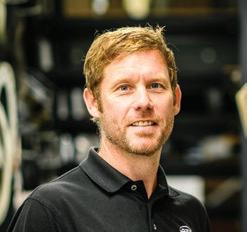
Warehousing and logistics play a vital role in many businesses’ day to day operations, but they can also have a detrimental effect on the environment around them.
The great news is that many businesses appreciate and understand the issue and the positive impact they can have with the right approach. It’s not just multinational corporations that can make a difference, everyone from local wholesalers and builders’ merchants to utility providers can help to encourage change. Opinions on how to achieve sustainability can vary but by following some best practices you can get some instant results.
Reduce, reuse, recycle
I am sure we all recycle much of the waste we produce, but that should be the last resort. By far the simplest change you can make is by repurposing the material you receive your goods in. Can the box be used again? Can it be shredded and used as padding for your own deliveries or returns?
You can also make changes within your procurement policy and ensure those suppliers that wish to trade with you do the simple things right, such as using reused or 100% recyclable materials on their shipments to you.
Energy efficiency
This doesn’t just mean solar panels and sensors, although these are obviously highly effective and very important. You can also take advantage of natural light with the use of skylights or translucent roofing panels. Used in conjunction with thoughtfully considered layout of your storage equipment, you may not need your lights turned on all day.
Maximise your space
Using high density storage solutions can help to provide better warehouse sustainability. Put simply, systems such as these will enable you to store more in less space. This is particularly effective within areas that are temperature controlled as this can reduce the costs regarding energy used per pallet.
Efficient layout
Just as important is to make sure that the storage equipment you choose is designed and installed to streamline the operations taking place within it. This includes procedures such as goods in, returns, picking, packing and goods out. Ensuring these flow smoothly will reduce the time taken across your entire operations, boosting efficiency.
Preventative maintenance
Ensuring you or your contractors carry out PPM on your warehouse infrastructure, storage equipment and machinery can help to prevent shutdowns. Businesses that do so can increase safety and efficiency within their logistics facilities by anticipating and preventing problems through preventative maintenance.
Go paperless
Already implemented by the majority of businesses, printing unnecessary amounts of paperwork is still something many are guilty of. Ensuring we only print paper where it is absolutely necessary can have a huge impact on the sustainability of your business by simply reducing the manufacturing costs of the paper alone, and that’s before considering the energy required to recycle. Thankfully this type of guidance is readily available from companies operating within the storage equipment and logistics business, and concepts such as the green logistics framework are now in place. These include sustainable policies and measures designed to reduce the environmental impact caused by companies within this industry. There are clear objectives to measure carbon footprints, reduce pollution and improve the design of products and packaging to minimise their impact on the environment.
Sustainability, when fully understood, not only impacts the world in a positive way but can save businesses money too, surely a win win situation.

